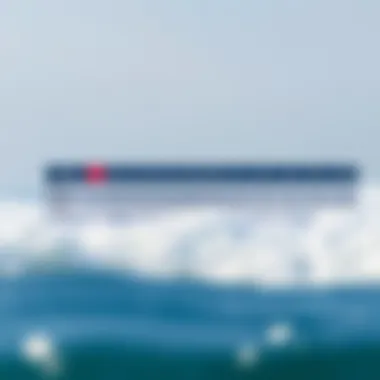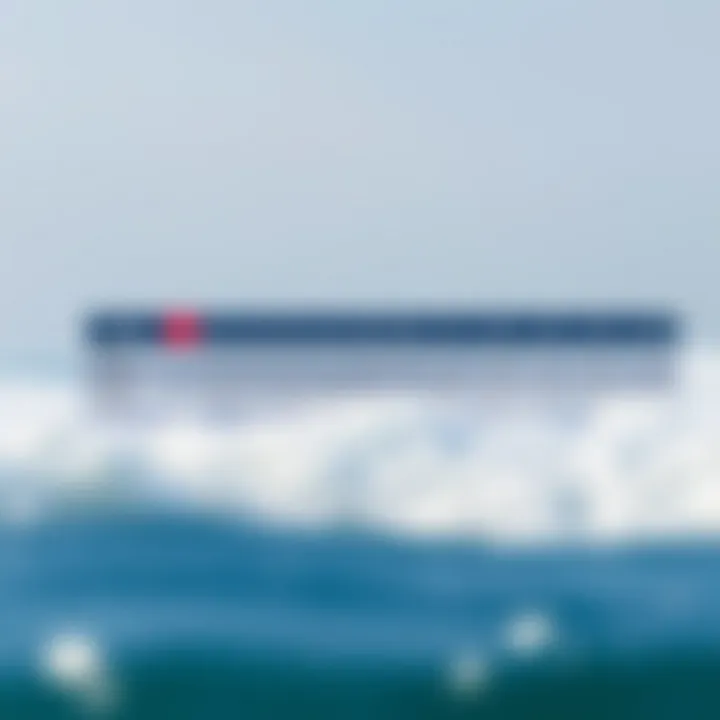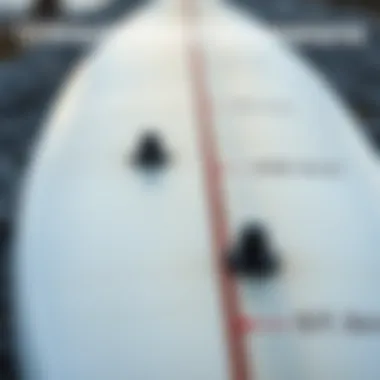Decoding the Shortboard Size Chart for Surfers


Intro
Understanding the shortboard size chart is not just a passing concern for surfers—it's a fundamental aspect that can define your entire surfing experience. Selecting the right board is akin to finding the perfect pair of shoes; it shapes your comfort, performance, and ultimately your enjoyment on the waves. In this guide, we will take a look at the critical elements that come into play when interpreting the shortboard size chart. The endeavor involves more than just considering a few digits; it encompasses your body dimensions, surfing style, and the specific conditions you intend to surf in.
For both novices and seasoned beach bums alike, navigating the nuances of shortboard characteristics simplifies the decision-making process significantly. You will find that this guide gives vital insights into everything from basic board sizes to the latest technologies available, ensuring you leave the shore with the right board etched firmly in your mind.
Gear and Equipment
Latest Surfboard Technologies
Surfboard technology has evolved by leaps and bounds over the years. Modern boards come with various features designed for enhanced performance and durability. One can find boards made from advanced materials like epoxy, which offer greater buoyancy and resistance. This contrasts with traditional polyurethane boards that have served surfers for decades. Innovations like contoured bottom shapes also play a significant role, as they influence how your board interacts with the ocean's surface. If you're after speed, you might consider a board with a streamlined design, while a wider board could enhance stability on choppier waters.
Essential Accessories for Every Surfer
No surfer is complete without the right set of accessories to complement their gear. Whether you're new to the sport or a veteran of the waves, packing the essentials can make a world of difference.
- Leash: This is crucial for keeping your board tethered to you. A quality leash can save time retrieving your board after a wipeout.
- Wax: Surfboard wax ensures you have the grip needed to stay upright — unless you enjoy the occasional dip.
- Board Bag: Protecting your investment is essential. A padded board bag will keep your shortboard safe from dings and scratches, especially during travel.
- Sun Protection: Don't overlook the importance of sunscreen. The sun can be relentless, and your skin is just as important as your gear.
"The right gear doesn’t make the surfer, but it certainly helps when you're battling the elements."
Inbreeding these fundamentals allows surfers to focus on honing their skills rather than worrying about their equipment. Next up, we'll dive deep into the skills required for both beginners and advanced surfers, showcasing techniques that can elevate your surfing to the next level.
Preface to Shortboards
Shortboards hold a special place in the surfing world. They symbolize agility and performance, helping surfers to maneuver swiftly and carve through waves. Understanding shortboards is paramount, especially for those looking to elevate their surfing game. By familiarizing oneself with these sleek designs, surfers can match their equipment with their body type, skill level, and preferred riding styles. Choosing the right shortboard isn’t just about aesthetics; it's about optimizing performance in varied conditions.
Defining Shortboards in Surfing
In essence, a shortboard is a type of surfboard typically less than 6 feet in length. These boards are designed for high-speed performance and sharp turns, making them ideal for experienced surfers who enjoy riding powerful waves. The shorter length allows for enhanced maneuverability, enabling surfers to execute intricate tricks and sharp cuts.
Characteristics that define shortboards include:
- Narrow Nose: Helps to reduce drag and improve control.
- Thruster Fin Setup: Most shortboards use a three-fin setup, which grants better grip during turns.
- Rockered Bottom: The curve of the board enhances performance in various wave conditions.
While many enjoy riding shortboards, the key lies in understanding how these elements work together to provide a thrilling surf experience. Surfers must consider their individual physical attributes and riding style to select a shortboard that aligns well with their abilities.
Historical Context and Evolution
The history of shortboards is as dynamic as the waves they ride. In the 1960s, surfboards began evolving, moving away from longer, heavier models. The surfing world started to embrace shorter, lighter boards that allow for quicker maneuvers and better speed.
The shift began with innovators like the legendary Greg Noll and later, the designs were refined by influential shapers such as Billabong and Channel Islands. By the 1980s, the shortboard revolution had taken off, with new materials like polyurethane foam and fiberglass allowing boards to shrink in size while maximizing performance.
By the 1990s, the introduction of new designs led the way for boards tailored to different surf styles, shifting away from the one-size-fits-all mentality. The connection between surfers today and these pioneering designs reflects a continued evolution in surfing culture.
A crucial takeaway is that understanding shortboards and their evolution aids surfers in making informed decisions. With a richer appreciation of history, surfers can better grasp their craft and appreciate the nuances that come with selecting the right equipment.
Understanding the Size Chart
When navigating the world of shortboards, understanding the size chart is nothing short of pivotal. It’s the roadmap that guides surfers toward board dimensions that complement their physiques and preferences. Picking up a shortboard without this knowledge is akin to steering a ship without a compass; it may lead to an experience that can range from frustrating to downright unsatisfactory.


The charts provide more than just numbers—they convey a board’s potential, efficiency, and suitability. Every surfer, from the budding enthusiast to the seasoned wave-rider, should regard these measurements as their closest allies. Knowing how dimensions relate to performance can make surf sessions more enjoyable and effective.
Significance of Board Dimensions
Board dimensions are the bedrock of what distinguishes one board from another. Each measurement—length, width, thickness—plays a key role in the overall performance and feel of the board in the water. Essentially, they define how the board handles waves, responds to turns, and maintains speed.
In addressing these dimensions, surfers can find the perfect fit for their specific needs. A correct understanding helps in enhancing the overall ride experience, granting riders the confidence to maneuver through waves, control speed, and carve turns.
Key Dimensions Explained
Length
The length of a shortboard usually ranges from 5 to 7 feet, with a typical average around 6 feet. A longer board can provide more stability and paddling power, aiding in catching waves efficiently. Shorter boards, on the other hand, excel in maneuverability and are more suited for quick turns and tricks.
A key characteristic of length is how it directly influences wave performance. Shortboards are often favored for their ability to perform sharply, enabling advanced maneuvers and swift shifts in direction. However, one downside of too short a length is the potential for reduced stability during heavy conditions. Riders must weigh the trade-off between stability and agility when making their choice.
Width
Width refers to how broad the board is, and it typically measures between 16 to 20 inches. A wider board offers more surface area, translating to increased floatation, which is particularly advantageous in weaker surf. Conversely, a narrower board promotes better cutting through the waves and reduces drag, making it a popular choice for experienced surfers who favor speed.
The unique feature of width lies in its direct impact on balance. Wider boards assist beginners by creating a larger platform for learning and practicing balance. Yet, as a surfer's skill level advances, they may find that too much width hinders quick, sharp moves on the waves.
Thickness
Thickness usually ranges from 2 to 3 inches and can dramatically affect the buoyancy and responsiveness of the board. Thicker boards tend to float better, making them ideal for surfers who prioritize paddling and wave catching. On the flip side, thinner boards often weigh less and can respond more quickly to the rider's input, which is crucial for performing advanced tricks and maintaining speed.
A significant aspect related to thickness is its influence on how the board interacts with diverse wave conditions. While a thicker board might shine in smaller, mushier waves, it could feel cumbersome when navigating steep, powerful surf. Balancing thickness with both skill level and wave conditions forms part of the strategic decision-making process when contemplating a new board.
In wrapping up this section, understanding these dimensions is paramount to choosing a shortboard that not only fits comfortably but also enhances performance in various wave conditions. Keep those measurements in mind; they’re your golden ticket to catching waves like a pro!
Factors Affecting Shortboard Size Selection
Selecting the right shortboard is a critical decision for surfers, as it directly impacts performance and overall enjoyment on the waves. Several elements play a crucial role in determining the appropriate size for each surfer. Understanding these factors can mean the difference between struggling through a session and riding high with complete confidence. Surfers must consider their personal attributes, skill levels, and the types of waves they typically encounter when choosing their boards.
Height and Weight Considerations
When it comes to picking a shortboard, height and weight are foundational factors. These two characteristics go hand in hand, influencing not only the board size but also its shape and volume. For example, a taller surfer typically requires a longer board to ensure stability and a balanced ride. Conversely, a heavier surfer might need a thicker board to provide the necessary buoyancy and prevent sinking. In practical terms:
- A surfer standing at 6 feet may find an ideal board length around 6’2" to 6’4”, while someone at 5'6" might find 5'8" to 5'10" more suitable.
- Likewise, for weight, if a surfer clocks in at 180 pounds versus one at 150 pounds, the latter might opt for a thinner profile to ensure agility and responsiveness in maneuvering. Thus, evaluating weight alongside height can enhance one's ability to select an optimal shortboard, ultimately leading to a more enjoyable surfing experience.
Skill Level and Riding Style
Skill level significantly affects shortboard selection. Whether someone is a novice looking to catch their first waves, or an expert carving through barrels, the board will differ considerably. Beginners often benefit from wider, more stable boards that offer greater forgiveness during wipeouts. These boards typically have increased volume, which provides extra buoyancy, making it easier to paddle and catch waves.
- For beginners:
- For intermediate surfers:
- For advanced surfers:
- Ideal width ranges from 19" to 20".
- Opt for boards with a less pronounced rocker to promote easier paddling and more straightforward riding.
- Transition boards that offer a blend of stability and maneuverability often have a slightly narrower profile.
- Custom sizes tailored to preferred riding styles can come into play. They may opt for narrower or more specialized shapes to execute technical moves.


Understanding one's riding style also guides size choices. Some surfers prefer aggressive turns and sharp maneuvers, requiring a board that allows for quick transitions. Others may favor cruising down the line, indicating a longer board could be more beneficial.
Wave Conditions and Types
Lastly, the wave conditions and types encountered frequently are crucial in deciding the right shortboard size. Surfers who typically ride smaller, softer waves might benefit from shorter boards that enhance maneuverability. This is because these shorter boards enable quicker turns, making them ideal for handling less powerful waves. On the flip side, bigger, more powerful waves demand more substance in a board. Here’s what to consider:
- Smaller Waves:
- Bigger Waves:
- A shorter and wider board can provide easier wave catching and facilitate more tricks.
- Look for boards around 5'6" to 5'10" with a volume suited to your weight and skill level.
- Longer boards that are more streamlined may be pivotal for stability and control, typically ranging from 6'2" to 6'8".
- Consider boards with a pronounced rocker to handle steep take-offs effectively.
In summary, height, weight, skill level, riding style, and wave conditions collectively shape the decision-making process for surfers in their quest for the perfect shortboard. By taking these factors into account, surfers not only enhance their performance but also maximize their enjoyment on the water.
"The right board doesn’t just float; it transforms your surfing experience. Choose wisely!"
By understanding the nuances of these aspects, surfers can align their board choice with their unique needs, ultimately leading to a more fulfilling ride.
Interpreting the Size Chart Effectively
Understanding how to interpret the shortboard size chart is crucial for surfers wanting to optimize their performance. A size chart is more than just numbers; it serves as a roadmap that guides surfers based on their personal measures, such as height and weight, while also considering other factors like skill level and intended wave conditions. Effectively interpreting the size chart allows surfers to pick a board that not only fits their physique but also complements their style of riding.
Choosing the right board can make all the difference in how one feels riding the waves. Mismatched dimensions can lead to a variety of issues, such as difficulty in paddling, carving, and catching waves. This section breaks down how to translate size chart figures into suitable board choices for various types of surfers.
Matching Body Size to Board Specifications
When we talk about matching body size to board specifications, it’s about more than just height and weight. Each surfer is unique, and exploring the nuances can lead to better performance.
- Height: Generally, taller surfers may consider a longer board. A board that’s too short can hinder stability, while a longer board might be more suitable for larger individuals.
- Weight: Heavier surfers need a thicker board to ensure proper buoyancy. Too thin of a board could sink, making it hard to get out there on a wave.
- Skill Levels: A beginner may prioritize volume, which provides more flotation and stability. Conversely, advanced surfers might opt for more refined sizes that enhance their maneuverability and speed on the water.
By understanding these principles, surfers can decipher size charts and select boards that cater to their specific characteristics. It helps to think of this as tailoring a suit. Just like a good fit is essential for style and comfort, so is the right board size for optimal surfing experience.
Using Size Charts from Different Brands
Size charts can vary between brands, creating some confusion for surfers navigating their options. Here's a closer look at this issue and how to tackle it:
- Brand Variation: Different manufacturers have unique philosophies in designing boards, which means their size charts may use slightly different criteria. A board from Lib Tech may handle differently than one from Channel Islands, even if they have the same dimensions on paper.
- Terminology Differences: Some brands might refer to lengths and widths differently. A board labeled as a "pro model" may have variations in its specifications due to design elements aimed at expert surfers. Be cautious with language as it can imply more than just size.
- Testing for Fit: When possible, trying out boards from various brands can help surfers gauge their preferences in shape and feel. This hands-on experience often provides insights far beyond what size charts can express.
For more details about surfboard selections, you may explore resources like Surf Science or check discussions on Reddit Surfing.
"Choosing your board is the first step, and understanding its dimensions is just as vital."
Keep these considerations in mind; they can make a world of difference in your surfing journey.
Shortboard Characteristics and Performance
Understanding the characteristics and performance of shortboards is crucial for surfers keen on maximizing their experience in the water. These boards are designed not just for speed and agility but also for tackling specific wave conditions effectively. Both the benefits and limitations of shortboards play a significant role in informing surfers' choices based on their skill level, wave environment, and personal preferences.
Benefits of Shortboards
Shortboards present a variety of advantages that align well with the needs of many surfers:
- Maneuverability: Shortboards are typically shorter and thinner, allowing for quick turns and snaps that are essential for aggressive surfing styles. This is particularly beneficial when riding steeper waves, where quick reflexes can make all the difference.
- Speed: The design allows for greater speed on the wave face. A shorter board can generate speed rapidly, enabling surfers to maintain momentum even when carving closely to the wave's edge.
- Aerodynamics: With less volume than longboards, shortboards can cut through water more smoothly. This gives a distinct advantage when facing challenging conditions where precision is key.
- Performance on Steep Waves: Shortboards shine in overhead conditions. Their compact design helps surfers dominate in challenging surf, allowing for impressive aerial maneuvers and tricks.


"The right shortboard can elevate a surfer's performance exponentially, turning average rides into gravity-defying feats."
As thrilling as the benefits are for surfers looking to push their limits, it’s equally important to be aware of the limitations that accompany shortboard usage.
Limitations of Shortboards
While shortboards have their perks, they aren't without drawbacks:
- Paddle Difficulty: Shortboards often require more effort to paddle out, especially for less experienced surfers. The reduced surface area means less buoyancy, making it harder to catch waves in the first place.
- Stability Issues: Due to their size, shortboards can feel less stable compared to longer boards, particularly for beginners. This can lead to wipeouts or missed opportunities to catch waves.
- Not Ideal for Small Waves: Surfers might find shortboards challenging in smaller, mushy conditions where the speed and agility of the board do not translate well. In such cases, a longer board may provide better performance.
- Skill Requirements: It's worth noting that shortboards generally demand a higher skill level. For novices, stepping onto a shortboard might not be the best introduction to surfing, as it limits their ability to balance and ride waves effectively.
A careful consideration of these characteristics helps learners and seasoned surfers alike make informed decisions about shortboards, maximizing their enjoyment and skill development in the surf.
Recommendations for Different Skill Levels
Choosing the right shortboard size can be a game-changer for surfers, affecting not just performance but also the overall enjoyment of the ride. Each skill level comes with its unique set of preferences, challenges, and techniques. Therefore, tailoring board selections to fit these specific requirements is crucial. This section delves into key recommendations aimed at beginners, intermediate, and advanced surfers, highlighting their distinct needs and desires in pursuit of the perfect wave.
Beginners: Ideal Board Sizes
For those just dipping their toes in the ocean, starting off with the right shortboard size is essential. The board should not only be manageable but should also help build confidence as new surfers dial in their skills. Generally, beginners are advised to choose a board that is slightly longer and wider to enhance stability. A board that’s around 6'0" to 6'4" in length and has a broader width can offer that added buoyancy and help with balance. These dimensions pave the way for a more forgiving ride, making it easier to catch smaller waves as one begins to learn the ropes.
One practical tip is to look for boards with a lower rocker. This generally helps with paddling efficiency and gliding ease, making it less strenuous for newbies to get into the waves. As they progress and gain more comfort in the water, they can start experimenting with shorter and narrower boards.
"Sticking with an accommodating size allows beginners to grow their skills without the frustration of constant wipeouts."
Intermediate Surfers: Transitioning Boards
Once surfers become more comfortable and capable, their board size may need an upgrade. Intermediate surfers typically look for a bit more performance from their boards while still wanting to maintain comfortable control. A good rule of thumb for these surfers is to consider a board size ranging between 5'8" and 6'0". At this stage, it’s also vital to factor in personal riding style and the types of waves frequently surfed.
Intermediate surfers may opt for boards with a mix of versatility; a slightly narrower width helps with maneuverability while still maintaining some stability. Also, moderate rocker profiles will aid in sharper turns without sacrificing speed. The transition phase can be daunting, but it can also be thrilling to explore the nature of the ocean with a board that resonates with a surfer's evolving skill set.
Advanced Surfers: Custom Size Selection
For advanced surfers, the relationship with the board becomes much more nuanced. At this level, performance, precision, and personal preference take center stage. Riders typically lean towards shorter sizes in the adventure range of 5’6" to 5'10" to enhance speed and responsiveness. However, this doesn’t mean ‘one size fits all.’ Customization is the name of the game.
Things such as thickness, tail shape, and rocker are carefully considered. Many advanced surfers experiment with various board specs to find how they interact with unique wave conditions and personal riding styles. Having the ability to communicate their desires to a shaper can lead to the perfect fit. Ultimately, the goal at this stage is to achieve the right balance between agility and stability that best suits individual techniques and preferences.
Selecting the appropriate shortboard size is not just a matter of numbers; it’s a well-thought-out balance between skill level, personal style, and the dynamics of surfing conditions. Understanding the nuances can make all the difference in unlocking one’s potential on the waves.
Culmination
In wrapping up our exploration of shortboard sizing, it's crucial to recognize the multilayered importance of understanding the interplay between a surfer's physical attributes and the technical specifics of board dimensions. This article has highlighted not just the basic measurements—length, width, and thickness—but also the broader implications related to skill level, riding style, and individual wave conditions. Recognizing these elements empowers surfers to make informed decisions that can markedly enhance their performance on the water.
Summation of Key Points
The previous sections shed light on various pivotal aspects:
- Defining Shortboards: Establishes what shortboards are and how they've evolved over time.
- Size Chart Importance: Emphasizes why the dimensions of a board matter for different surf conditions and styles.
- Factors Influencing Size Selection: Discusses considerations like personal physique, experience level, and the nature of the waves one expects to face.
- Interpreting Size Charts: Provides practical guidelines on how to effectively utilize size charts from various brands, ensuring surfers are equipped with the right board.
- Performance Characteristics: Highlights unique benefits and limitations of shortboards, tailored to different types of surfers.
- Recommendations Across Skill Levels: Offers precise advice for beginners, intermediates, and advanced surfers.
Each of these components works in tandem to provide a nuanced understanding of shortboard selection, establishing a solid foundation for anyone serious about improving their surfing experience.
Final Thoughts on Shortboard Size Selection
Selecting the right shortboard is far from a simple endeavor. It requires integrating various personal factors and situational contexts to arrive at an ideal choice. Keep in mind the following considerations:
- Align your choice with your body size and fitness level; this is not just about matching numbers but understanding what feels right.
- Remember that surf style plays a pivotal role in shaping your board choice. Whether you prefer agile maneuvers or riding powerful waves, the right board can make all the difference.
- Stay informed about evolving trends in board design and innovations that could impact your riding performance.
Ultimately, investing time to comprehend the size chart and aligning your preferences with practical choices will elevate your satisfaction on the waves. An informed surfer is a thriving surfer, capable of maximizing each ride and experiencing the true joy that comes with mastering one's craft. For additional insights and discussions, you can explore resources fromWikipedia, Britannica, or Reddit.







